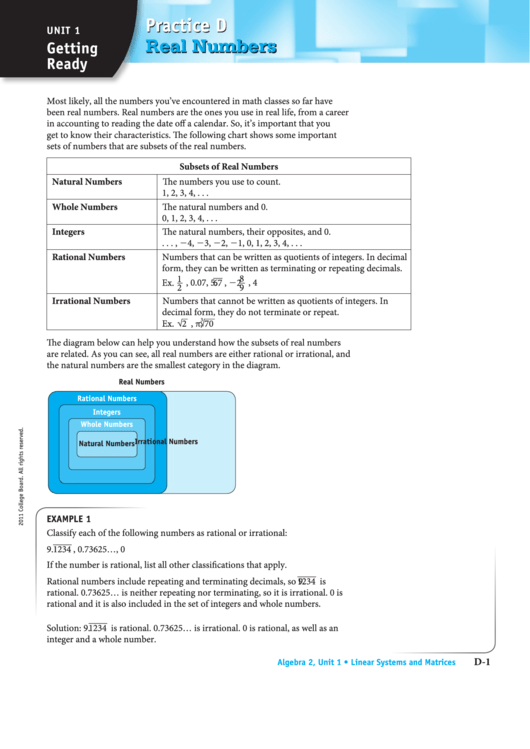Real Numbers Worksheet Template
ADVERTISEMENT
Practice D
Unit 1
Real Numbers
Getting
Ready
Most likely, all the numbers you’ve encountered in math classes so far have
been real numbers. Real numbers are the ones you use in real life, from a career
in accounting to reading the date off a calendar. So, it’s important that you
get to know their characteristics. The following chart shows some important
sets of numbers that are subsets of the real numbers.
Subsets of Real Numbers
Natural Numbers
The numbers you use to count.
1, 2, 3, 4, . . .
Whole Numbers
The natural numbers and 0.
0, 1, 2, 3, 4, . . .
Integers
The natural numbers, their opposites, and 0.
. . . , −4, −3, −2, −1, 0, 1, 2, 3, 4, . . .
Rational Numbers
Numbers that can be written as quotients of integers. In decimal
form, they can be written as terminating or repeating decimals.
__
Ex. 1
67 , −2 8
__
__
, 0.07, 5.
, 4
2
9
Irrational Numbers
Numbers that cannot be written as quotients of integers. In
decimal form, they do not terminate or repeat.
__
___
3
Ex.
2 , π,
70
√
√
The diagram below can help you understand how the subsets of real numbers
are related. As you can see, all real numbers are either rational or irrational, and
the natural numbers are the smallest category in the diagram.
Real Numbers
Rational Numbers
Integers
Whole Numbers
Irrational Numbers
Natural Numbers
EXAMPLE 1
Classify each of the following numbers as rational or irrational:
____
9.
1234 , 0.73625…, 0
If the number is rational, list all other classifications that apply.
____
Rational numbers include repeating and terminating decimals, so 9.
1234 is
rational. 0.73625… is neither repeating nor terminating, so it is irrational. 0 is
rational and it is also included in the set of integers and whole numbers.
____
Solution: 9.
1234 is rational. 0.73625… is irrational. 0 is rational, as well as an
integer and a whole number.
D-1
Algebra 2, Unit 1 • Linear Systems and Matrices
ADVERTISEMENT
0 votes
Related Articles
Related forms
Related Categories
Parent category: Education
 1
1 2
2 3
3 4
4








